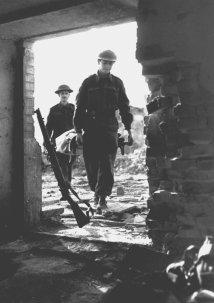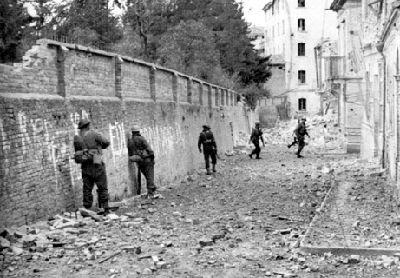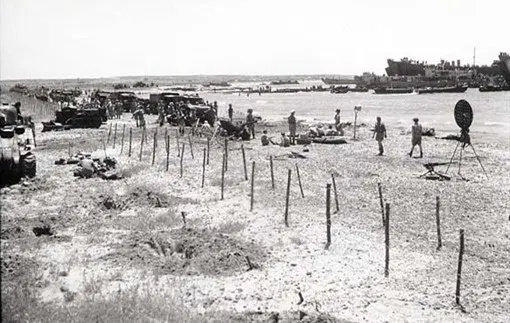
Wartime Heritage
ASSOCIATION

Remembering the Italian Campaign
Forty-two ships carrying Canadian soldiers departed Great Britain on June 25, 1943. On board were the 1st Canadian
Infantry Division and the 1st Canadian Army Tank Brigade. They didn’t know where they were going, and it was not until July 3rd,
as they passed through the Straits of Gibraltar that they learned they were to be part of an Allied invasion of Sicily.
On June 28th, a second convoy group that included ten ships transporting Canadians departed Great Britain. In the two
convoys Canadians numbered some 26,000 troops, with tanks, artillery, and supplies.
Two additional convoys would bring supplies and troops, all part a total invasion force of some 3000 ships and landing craft.
But the convoy of June 25th lost three ships from enemy attack. Fifty-two Canadians drowned, including six from Nova
Scotia. A significant amount of equipment was also lost, including vehicles, artillery, and signals equipment. The Royal Canadian
Army Medical Corps’ lost personnel and medical supplies.
The Allied invasion of Sicily, codenamed
Operation Husky, was a major campaign of World
War II.
As the first step, on July 10, 1943, the
American 5th Army and the British 8th Army that
included the Canadians landed in Sicily. On the left
flank of the British were the Canadians. Flotillas of
Royal Canadian Navy landing craft supported the
troops. Three Canadian bomber squadrons operated
from bases in Tunisia to support the invasion in
Sicily and later in Italy. The RCAF, flew Spitfire
aircraft from the first to last of the Italian campaign.
The battle lasted thirty-eight days. Canadians
came ashore carrying 70 or 80 lbs. of equipment,
fought in hot, dusty weather battling through difficult terrain. They were sunburned through their shirts, but medical teams did
devise a sunscreen - iodine and olive oil - and it worked!
Sicily was the first real test in WWII of what the Canadian army could accomplish. They fought through 210 km of the
mountainous country farther than any other formation in the 8th British army.
Andre Boudreau of Wedgeport served with the West Nova Scotia Regiment. He was twenty-four when he enlisted in January
1940. On August 2nd, 1943, he was killed in action - one of three, born in Yarmouth County buried in a WWII cemetery in Sicily.
With the enemy driven out of Sicily, the Allies invaded mainland Italy. Elements of the Eighth Army, including the Canadians,
landed in the 'toe' of Italy on September 3, 1943. The enemy forces were determined to hold the Italian mainland and took
advantage of the mountainous landscape turning the length of the Italian peninsula into a series of defensive positions protected
with machine-gun nests, barbed wire, land mines, and artillery positions.
The 5th Canadian Armoured Division arrived from Great Britain in November and the Canadians with other Allied troops
battled up the Italian mainland successfully pushing back the enemy in villages, towns, and cities. James VanAmburg, aged 18, of
Tusket, John Harris, aged 24, of Comeau’s Hill, Malcolm Brittain, aged 23, of Forest Glen, Freeman Grant, aged 17, of Carleton
and Emile Joseph Comeau of Beaver River were five from Yarmouth County killed in action as the Canadians fought toward Ortona
in December of 1943.
In November 1943, Canada dispatched the 5th Armoured Division to the Mediterranean theatre. Now, among the Canadian
forces in Italy were the Princess Louise Fusiliers, the Irish Regiment of Canada, and the Lanark and Renfrew Scottish Regiment.
They joined the West Nova Scotia Regiment, the 48th Highlanders of Canada, the Carleton and York Regiment and the Royal
Canadian Dragoons in the fighting. These units included many of the veterans of the Wedgeport Legion and in particular, Henry
O'Connell and Charlie Muise.
At Ortona, its narrow, rubble-filled streets limited the use of
tanks and artillery and the Canadians engaged in vicious street
fighting. The town was liberated on December 28, after more than a
week of battle.
During April and May 1944, the Canadians moved across Italy
to join the Americans in the struggle for Rome. On May 22, John
Edward Doucette, with the 48th Highlanders of Canada, and on May
24, Phillip Joseph Blanchard with the West Nova Scotia Regiment
were killed in action. Two soldiers from Quinan, buried in the
Cassino War Cemetery. A memorial stone at the entrance to the
cemetery in Quinan, ensures that these two soldiers will always be
remembered by the village and those who visit the cemetery.
Phillip Blanchard was a very good singer and a guitar player. An uncle told the story of Phillip’s departure and going with him
to the train station to see him, off. The uncle had purchased a pint of rum for Phillip, a little something to have during the
journey. But, not wanting to make anyone aware of this, he attempted to slip it into Phillip’s pocket as the soldiers were ready to
board the train. Thinking he had successfully slipped the pint into the pocket unknown to others, he let go of the bottle. The pint
fell to the ground and smashed! There was no special treat for Phillip on the train!
May 23, the worst day in terms of casualties for the Canadian Army in Italy, saw 890 Canadians killed or wounded. Among the
dead would be Arnold Clayton White of Carleton and James Muise of Yarmouth.
The Eighth Army continued up the Liri Valley towards Rome against fierce resistance. The capture of Ceprano on May 27th
broke the German resistance and Rome fell on June 4th, but Canadians did not march triumphantly into the city. They were
placed in reserve several days before and the American forces entered Rome. As one Canadian veteran put it “we did all the hard
fighting and the Americans marched into the city as liberators”.
The fall of Rome and the D-Day landings in France two days later, made Italy seem so much less important.
But the fighting went on and the Canadians played a leading part in the breaking of the Gothic Line, crossing the Peninsula
north of Florence, throughout August and September. August 31, saw the death of Trooper Joseph Walter Deveau, serving with
the 5th Armoured Brigade.
On November 1, Henry James Muise, from Sluice Point, serving with the Cape Breton Highlanders was killed in action.
After spending November in reserve, the Canadians returned to attack Ravenna. The city fell on December 4th, and on that
day James Theodore Doucette of Wedgeport, fighting with the Princess Louise Fusiliers, was killed in action. He enlisted on
February 4, 1941. Henry O’Connell can tell you a story of James Doucette. He was a boxer and during training in Halifax in 1941,
he and Arthur LeBlanc used to box together in their spare time, just for fun. Arthur LeBlanc also served with the Princess Louise
Fusiliers and was a veteran of the Italian Campaign.
Private Pervin O’Neil, serving with the West Nova Scotia Regiment, aged 24, of Deerfield was killed on December 10th.
Many remember the mud, the rain, the cold in winter, and the endless shelling. Henry O’Connell served as the nose machine
gunner in a 15-ton armored car and later in an open American White scout car … armored reconnaissance … seek out the enemy,
withdraw so the infantry could go in … he didn’t want to be in the infantry, but in the fall of 1944 their vehicles got stuck in the
mud … so after a few days, he was moved to the front to assist the infantry to hold the lines. He arrived at 10:00 am. It was
October 11, 1944. At 1:00 pm he was hit by shrapnel. He was hospitalized until just before Christmas. Again, he was wounded
on January 11th, 1945. His closest call from the enemy guns came when a shell hit a few feet from his armored car. He survived;
the second machine gunner did not.
Charlie Muise served with the Irish Regiment of Canada in Italy. He can tell us about the terror of those enemy 88 guns. He
and Simeon Maillet found themselves the target of a landing shell. When the dust settled, all one could see was Charlie’s helmet.
He had been buried in chunks of earth. Once dug out of the mud and clay and he confirmed he was intact, although just a little
shaken, he was hospitalized for a time before returning to the battle.
Veterans can tell you stories of not sleeping in beds for months, of climbing narrow mud
roads, freezing in the winter months because their winter gear didn’t arrive until December of
1943, of crossing endless rivers and valleys, repairing and building endless bridges, of eating
canned bacon, mostly fat, and bully beef, day after day, but thankful for it nevertheless, of
seeing hungry children, sharing food with them, of a Christmas Day at Ortona when the fighting
continued and soldiers died. And saddest of all, of seeing friends wounded and killed.
The campaign continued into the spring of 1945. In February the 1st Canadian Corps began
the move to Northwest Europe to be united with the First Canadian Army. There, they would
join in the drive into Holland and Germany.
Now, it was after D-Day that the Allied servicemen who fought in Italy during the Second
World War were sometimes referred to as the D-Day Dodgers. An American-born British politician
Nancy Astor first used the ill-considered term that implied cowardice and avoidance of the 'real'
war in France. The troops who had been fighting there for nine months felt slighted by her
ignorance and resented the implications of the phrase 'D-Day Dodgers'. The result was words to a song many servicemen in Italy
began to sing, set to the tune of “Lili Marlene.” The words generally, and sarcastically, refers to how easy the soldiers’ life was on
the Italian front.
We landed in Salerno, a holiday with pay,
The Jerries brought the bands out to greet us on our way
Showed us the sights and gave us tea,
We all sang songs, the beer was free.
But, it is the last verse that tells the real story …
Look around the mountains, in the mud and rain
See the scattered crosses, some which have no name.
Heartbreak, and toil, suffering gone
The boys beneath them slumber on
They are the D-Day Dodgers, who’ll stay in Italy.
The purpose for the Italian Campaign was to remove Italian troops from other areas of Europe, divert German forces from
France and reduce the strength of the German army. These goals were achieved.
In Sicily and in Italy, Canadians demonstrated that they were superior soldiers. 92,757 Canadian soldiers served in the
Campaign, 19,486 were wounded, 5,764 lost their lives. Thirty, born in various communities of Yarmouth Co., never returned. We
remember them, and we remember the veterans who served in the Italian Campaign.
Other Casualties from Yarmouth Co., NS
Frank Stephens D’Entremont of West Pubnico (Private, Carleton and York Regiment) killed in action July 18, 1943.
Leonard Arthur Dow of Yarmouth (Private, Hastings and Prince Edward Regiment) killed in action July 25, 1943.
Harold Fenwick Parker
of Yarmouth (Major, 4th Princess Louise Dragoon Guards)
killed in action November 4, 1943.
Charles Willard Rogers
of Yarmouth (Private, West Nova Scotia Regiment) killed in action November 22, 1943.
George Henry Lewis of Yarmouth (Private, West Nova Scotia Regiment) killed in action May 18, 1944.
James Gillis MacLellan
of Yarmouth (Private,West Nova Scotia Regiment), killed in action August 31, 1944.
Francis McLaughlin Larkin of East Pubnico (Lance Corporal, Cape Breton Highlanders)
killed in action September 10, 1944
Ernest Joseph Melanson of Yarmouth (Trooper
, Ontario Regiment) killed in action September 12, 1944.
William Joseph Muise of Chebogue, Yarmouth Co., (Private, Carleton and York Regiment, killed in action September 14, 1944
Carl Warren Alllen of Pembroke (Private, Carleton and York Regiment) killed in action September 18, 1944.
Leslie Oliver Vickery of Rockville (Private, West Nova Scotia Regiment) killed in action September 19, 1944.
Kenneth Higby of Yarmouth (Private, West Nova Scotia Regiment), killed in action October 23, 1944
Arthur Hatfield of Yarmouth (Private, Royal Canadian Army Service Corps) accidental death November 9, 1944
Alfred John Amero of Yarmouth (Sergeant, West Nova Scotia Regiment) killed in action December 2, 1944
Donald Hugh Lent of Overton (Sapper, Royal Canadian Engineers, 10 Field Sqn.) killed in action December 11, 1944
An abbreviated version was presented at the Royal Canadian Legion, Wedgeport
by George Egan
Chairman, Wartime Heritage Association
February 28, 2020

copyright © Wartime Heritage Association
Website hosting courtesy of Register.com - a web.com company
The Italian Campaign - WWII

Ortona

1st Canadian Division, engaged in brutal house-to-house fighting in
Ortona



- World War I - Menu
- WWI Stories and Articles
- Photos - Yarmouth Soldiers
- Selection of World War I Songs
- WWI Casualties of Yarmouth, NS
- Those Who Served - Yarmouth, NS
- WWI Casualties Digby Co. NS
- WWI Casualties Shelburne Co. NS
- Merchant Mariners (1915) Yarmouth, NS
- Canadian Forestry Corps - Non Yarmouth Birth/Residence Enlistments
- US Draft Registry - Yarmouth NS Born


- World War II - Menu
- WWII Stories and Articles
- Telegraphist Air Gunners
- WWII Casualties of Nova Scotia
- US Casualties with NS Connection
- Far East/Pacific Casualties with NS Connection
- Merchant Navy Casualties Nova Scotia
- Nova Scotia WWII Casualties Holten Canadian War Cemetery
- D-Day Casualties - Nova Scotia
- CANLOAN Program Casualties - Nova Scotia
- Battle of the Bulge Casualties - Nova Scotia
- WWII Casualties Yarmouth NS
- Yarmouth Casualties - RCAF RAF Canadian Army WWII
- Yarmouth Co., Marrages WWII
- Casualties Non-Born/Residents with Connection to Yarmouth Co., Nova Scotia.
- WWII Casualties Digby Co., NS
- Non-Nova Scotian WWII Casualties Buried in Nova Scotia
- WWII RCAF Casualties Aged 16-18
- Brothers/Sisters Who Served - World War II













